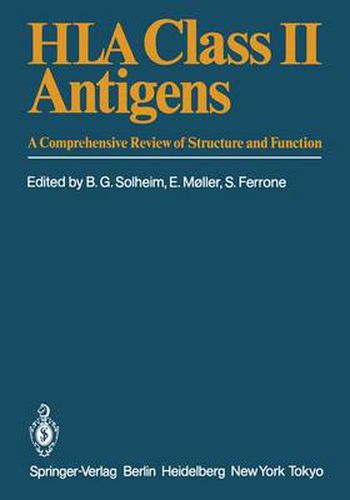Readings Newsletter
Become a Readings Member to make your shopping experience even easier.
Sign in or sign up for free!
You’re not far away from qualifying for FREE standard shipping within Australia
You’ve qualified for FREE standard shipping within Australia
The cart is loading…






This title is printed to order. This book may have been self-published. If so, we cannot guarantee the quality of the content. In the main most books will have gone through the editing process however some may not. We therefore suggest that you be aware of this before ordering this book. If in doubt check either the author or publisher’s details as we are unable to accept any returns unless they are faulty. Please contact us if you have any questions.
This volume deals with the structure and function of molecules that have, during the last decade, turned out to have a central role in immune responses. Trans plantation antigens were discovered and characterized by Gorer about 50 years ago, and the biological basis for the unequalled complexity of their variability between individuals within a species, in spite of extreme conservation between species, was the subject of intense research and discussion for many years. During the days of belief in immune surveillance against spontaneously developing tumors, it was suggested that histoincompatibility between members of one species would prevent cancer from being a contagious disease and thus a threat to the species. Immunologists involved in human transplantation had to learn and care about the complexity, especially after 1967, when it was found that HLA antigens were the products of the human MHC. Rejection of HLA-identical sib kidney grafts was so rare, even in those days, that cases of rejection were described in scientific papers.
$9.00 standard shipping within Australia
FREE standard shipping within Australia for orders over $100.00
Express & International shipping calculated at checkout
This title is printed to order. This book may have been self-published. If so, we cannot guarantee the quality of the content. In the main most books will have gone through the editing process however some may not. We therefore suggest that you be aware of this before ordering this book. If in doubt check either the author or publisher’s details as we are unable to accept any returns unless they are faulty. Please contact us if you have any questions.
This volume deals with the structure and function of molecules that have, during the last decade, turned out to have a central role in immune responses. Trans plantation antigens were discovered and characterized by Gorer about 50 years ago, and the biological basis for the unequalled complexity of their variability between individuals within a species, in spite of extreme conservation between species, was the subject of intense research and discussion for many years. During the days of belief in immune surveillance against spontaneously developing tumors, it was suggested that histoincompatibility between members of one species would prevent cancer from being a contagious disease and thus a threat to the species. Immunologists involved in human transplantation had to learn and care about the complexity, especially after 1967, when it was found that HLA antigens were the products of the human MHC. Rejection of HLA-identical sib kidney grafts was so rare, even in those days, that cases of rejection were described in scientific papers.